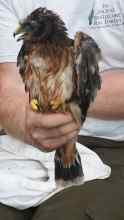This male was tagged on 7/7 at a site in the Ballyhoura Hills, North Cork, at approx. 28 days old. It’s nest site was in dense heather/gorse among 2nd rotation conifers, quite close to a used track high up the mountainside. This male was one of a brood of 3 that fledged successfully from the nest. After fledging he remained in the nest area for some weeks when he could be heard calling/begging for food and being fed by the adult female who was still on site.
This female was tagged on the 15th of July at an approximate age of 24-26 days. The nest was located at a traditional bramble and rush site in the Mullaghareirk Mountains in Co. Cork. Monitored by both staff and volunteers as part of IRD Duhallow’s RaptorLIFE project, the chick was in a brood of 2 and was the heaviest of all the 10 chicks tagged this year.
As part of this research 10 hen harrier chicks were tagged from ten different nests within the Slieve Blooms, Ballyhouras, Knockmealdown and Mullaghareirks mountains. Recent analysis of the incoming tracking data shows that that at least five of these birds are alive and well. Unfortunately, some of the tags are recording little to no activity (movement) indicating that these birds may have died. To date we have recovered one of the tagged chicks (a female from the Ballyhouras) but the precise cause of death was not conclusive.
Studying Irish hen harriers can be challenging. Many of us have taken part in the most recent national survey (2015) and enjoyed some great days out, perhaps the first sky-dancing male of the season or finding a pair at a new site or the first food-pass and female returning to a nest site. All this helps to give us a more or less complete picture of the status of Irish hen harriers and population trends over time (see Here). What has been shown to date is that nationally the species is declining while one or two subpopulations (eg. Slieve Blooms) appear to be relatively stable over time.








